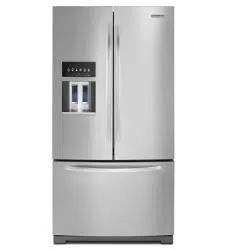Documents: Go to download!
User Manual
- User Manual - (English, French, Spanish)
- Dimension Guide - (English)
- Energy Guide - (English)
- Warranty Information - (English)
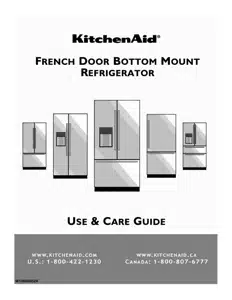
- REFRIGERATOR SAFETY
- Proper Disposal of Your Refrigerator
- PARTS AND FEATURES
- Energy and Normal Operating Sounds
- More Storage Space
- In-Door-Ice" Ice Dispensing System
- Dual Evaporator (on some models)
- Water Filter
- Air Filter
- Produce Preserver (on some models)
- Water Dispenser with Measured Fill
- LED Lighting
- Door Alarm
- Power Outage Indicator
- Location Requirements
- INSTALLATION INSTRUCTIONS
- Remove and Replace Refrigerator Doors
- Remove Right-Hand Refrigerator Door
- Replace Right-Hand Refrigerator Door
- Replace Left-Hand Refrigerator Door
- Final Steps
- Remove and Replace Freezer Drawer Front
- Remove Drawer Front
- Replace Drawer Front
- Final Steps
- Connect the Water Supply
- Connect to Water Line
- Connect to Refrigerator
- Complete the Installation
- Handle Installation and Removal
- Install Handles
- Remove the Handles
- Water Filtration $yste
- Install the Water Filter
- The Water Filter Status Light
- Replace the Water Filter
- Install Air Filter (on some models)
- Installing the Air Filter
- Installing the Filter Status Indicator
- Replacing the Air Filter
- Install Produce Preserver (on some models}
- Installing the Produce Preserver
- Installing the Status Indicator
- Using the Controls
- Viewing and Adjusting Temperature Set Points
- Adjust Temperature Set Points
- Additional Features
- Sabbath Mode
- Vacation Mode
- Water and Ice Dispensers
- Flush the Water System
- To Clean the Ice Dispenser Chute
- Ice Maker and Ice Storage Bin ( on some models)
- Ice Production Rate
- Crisper and Crisper Cover
- To remove and replace a crisper drawer:
- To remove the crisper(s) cover:
- To replace crisper(s) cover:
- Cleaning
- Interior Cleaning
- Condenser Cleaning
- TROUBLESHOOTING
- There is interior moisture buildup
- The ice maker is not producing ice or is not producing enough ice
- Water from the dispenser is warm
- The ice cubes are hollow or small
Table of contents
User manual Refrigerator for KitchenAid KFIS29PBMS
REFRIGERATOR SAFETY
Proper Disposal of Your Refrigerator
PARTS AND FEATURES
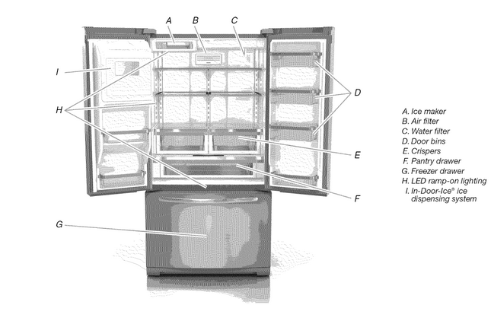
Energy and Normal Operating Sounds
- Your new French Door Bottom Mount refrigerator has been designed to optimize energy efficiency, and better regulate temperatures to match cooling demand. You may notice that it operates differently than your previously owned refrigerator. It is normal for the high-efficiency compressor to run for extended periods of time at varying speeds in order to consume only the energy necessary for optimum efficiency. In addition, during various stages of the cooling cycle, you may hear normal operating sounds that are unfamiliar to you.
More Storage Space
- The French Door Bottom Mount has the most fresh food storage space available, including a full-width, temperature controlled, pantry drawer perfect for storing veggie trays or party platters.
In-Door-Ice" Ice Dispensing System
- The ice storage bin located in the door provides an entire extra shelf of storage space, and the storage bin is removable for easy access to filtered ice.
Dual Evaporator (on some models)
- The refrigerator compartment and freezer compartment have separate evaporators to provide fresh food and frozen food with separate climates. The refrigerator stays cool and humid for the optimum storage of fresh foods while the freezer stays cold and dry. Humidity from the refrigerator does not mix with dry freezer air, so frost is controlled, which reduces freezer burn. Since no air is shared between the refrigerator and freezer, the transfer of food odors and tastes from the refrigerator to the freezer is eliminated.
Water Filter
- NSF®Certified filter reduces chlorine taste and odor, particulates (class I), lead, and mercury. Replacing the water filter every 6 months ensures clean, filtered drinking water.
Air Filter
- An air filter is 15 times more powerful than baking soda at reducing common food odors inside the refrigerator.
Produce Preserver (on some models)
- Ethylene is a natural gas produced by fruits and vegetables to promote ripening. The Produce Preserver absorbs ethylene, to delay the over-ripening of fresh produce. As a result, certain produce items will stay fresh longer.
Water Dispenser with Measured Fill
- The measured fill feature allows you to dispense the desired amount of filtered water.
LED Lighting
- The LED lights do not ever need to be replaced.
Door Alarm
- A helpful alarm sounds when the refrigerator door or freezer drawer is left ajar.
Power Outage Indicator
- If the power should go out while you are away from home, this indicator will let you know that the refrigerator has been without power.
Location Requirements
- IMPORTANT: This refrigerator is designed for indoor, household use only.
- To ensure proper ventilation for your refrigerator, allow for a 1/2" (1.25 cm) of space on each side and at the top. Allow for a 1" (2.54 cm) space behind the refrigerator. If your refrigerator has an ice maker, allow extra space at the back for the water line connections. When installing your refrigerator next to a fixed wall, leave a 33/4" (9.5 cm) minimum space between the refrigerator and wall to allow the door to swing open.
- NOTE: This refrigerator is intended for use in a location where the temperature ranges from a minimum of 55°F (13°C) to a maximum of 110°F (43°C). The preferred room temperature range for optimum performance, which reduces electricity usage and provides superior cooling, is between 60°F (15°C) and 90°F (32°C). It is recommended that you do not install the refrigerator near a heat source, such as an oven or radiator.
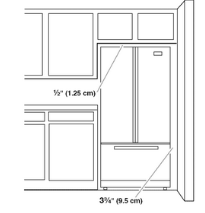
INSTALLATION INSTRUCTIONS
Remove and Replace Refrigerator Doors
NOTE: Measure the width of your door opening, to see whether or not you need to remove the refrigerator doors to move the refrigerator into your home. If door removal is necessary, see the following instructions.
IMPORTANT: If the refrigerator was previously installed and you are moving it out of the home, before you begin, turn the refrigerator control OFR Unplug the refrigerator or disconnect power. Remove food and adjustable door or utility bins from doors.
Gather the required tools and read all instructions before removing doors.
TOOLS NEEDED: 3/le" hex key wrench and a #2 Phillips screwdriver
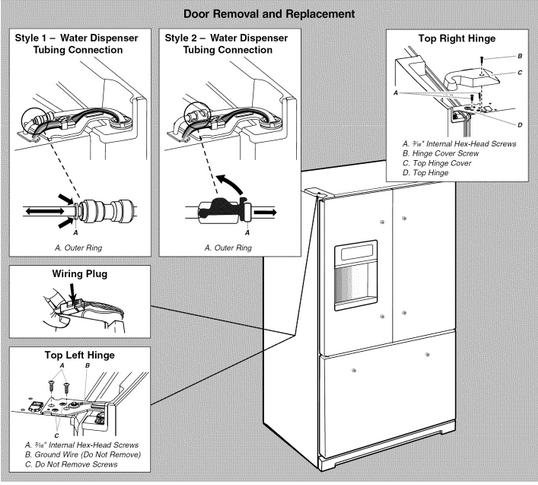
Remove Right-Hand Refrigerator Door
- Unplug refrigerator or disconnect power.
- Keep the refrigerator doors closed until you are ready to lift them free from the cabinet. NOTE: Provide additional support for the refrigerator door while the hinges are being removed. Do not depend on the door gasket magnets to hold the door in place while you are working.
- Using a Phillips screwdriver, remove the cover from the Top Hinge.
- Using the 3/le" hex key wrench, remove the two internal hex head screws from the top hinge, and set aside. NOTE: Do not remove the two Iocator screws. These screws will help you align the hinge when you replace the door.
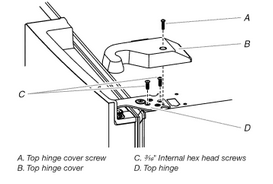
- Lift the refrigerator door from the bottom hinge pin. The top hinge will come away with the door.
Replace Right-Hand Refrigerator Door
- Set the right-hand door onto the bottom hinge pin.
- Insert the top hinge pin into the open hole in the top of the refrigerator door.
- Using the two 3/le" internal hex head screws, fasten the hinge to the cabinet. Do not tighten the screws completely.
Replace Left-Hand Refrigerator Door
IMPORTANT: Do not intertwine the water tubing and wiring bundles when reconnecting them.
- Set the left-hand door onto the bottom hinge pin.
- Using the two 3/le" internal hex head screws, fasten the hinge to the cabinet. Do not tighten the screws completely.
- Reconnect the water dispenser tubing.
Style 1 - Insert the tubing into the fitting until it stops and the outer ring is touching the face of fitting.
Style 2 - Insert the tubing firmly into the fitting until it stops. Close the clasp around the tubing. The clasp snaps into place between the fitting and the collar.
- Reconnect the electrical wiring.
- Push together the two sections of the wiring plug.
Final Steps
- Completely tighten the four internal hex head screws (two on the right-hand door hinge and two on the left-hand door hinge).
- Replace both top hinge covers.
Remove and Replace Freezer Drawer Front
Depending on the width of your door opening, it may be necessary to remove the freezer drawer front to move the refrigerator into your home.
IMPORTANT:
- If the refrigerator was previously installed and you are moving it out of the home, before you begin, turn the refrigerator control OFF, and unplug the refrigerator or disconnect power. Remove food from the freezer drawer.
- Two people may be required to remove and replace the freezer drawer front.
- Tool Needed: 1/4"hex driver
Remove Drawer Front
- Open the freezer drawer to its full extension.
- Remove the two screws at the top, inside the drawer front (one on the left-hand side and one on the right-hand side) that fasten the drawer front to the drawer glides.
- Lift up on the drawer front to release the plastic studs from the drawer glide bracket slots.

- Slide the drawer glides back into the freezer.
Replace Drawer Front
- Pull out the freezer drawer glides to their full extension.
- Holding the drawer front by its sides, align the two plastic studs, located at the bottom, inside the drawer front, with the drawer glide bracket slots. NOTE: It helps if one person holds the drawer glides steady while another person aligns the drawer front and inserts the studs into the slots.
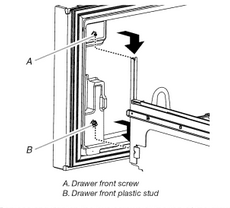
- Replace and tighten the two screws at the top of the drawer front (one on the left-hand side and one on the right-hand side).
Final Steps
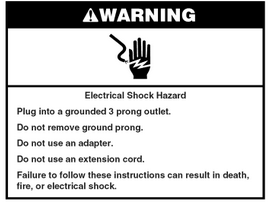
- Plug into a grounded 3 prong outlet.
- Reset the controls. See "Using the Control(s)."
- Return all removable door parts to doors and the food to refrigerator.
Connect the Water Supply
Read all directions before you begin.
IMPORTANT:
- Plumbing shall be installed in accordance with the International Plumbing Code and any local codes and ordinances.
- The gray water tubing on the back of the refrigerator (which is used to connect to the household water line) is a PEX (cross-linked polyethylene) tube. Copper and PEX tubing connections from the household water line to the refrigerator are acceptable, and will help avoid off-taste or odor in your ice or water. Check for leaks.
- Install tubing only in areas where temperatures will remain above freezing.
Connect to Water Line
IMPORTANT: If you turn the refrigerator on before the water is connected, turn the ice maker OFF.
- Unplug refrigerator or disconnect power.
- Turn OFF main water supply. Turn ON nearest faucet long enough to clear line of water.
- Use a quarter-turn shutoff valve or the equivalent, served by a 1/2"household supply line. NOTE: To allow sufficient water flow to the refrigerator, a minimum 1/2"size household supply line is recommended.
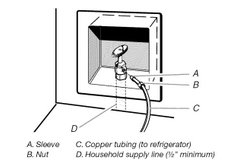
- Now you are ready to connect the copper tubing to the shutoff valve. Use 1/4"(6.35 mm) OD soft copper tubing to connect the shutoff valve and the refrigerator.
Ensure that you have the proper length needed for the job. Be sure both ends of the copper tubing are cut square.
Slip compression sleeve and compression nut onto copper tubing as shown. Insert end of tubing into outlet end squarely as far as it will go. Screw compression nut onto outlet end with adjustable wrench. Do not overtighten.

- Place the free end of the tubing into a container or sink, and turn on main water supply to flush out tubing until water is clear. Turn off shutoff valve on the water pipe. NOTE: Always drain the water line before making the final connection to the inlet of the water valve, to avoid possible water valve malfunction.
- Bend the copper tubing to meet the water line inlet, which is located on the back of the refrigerator cabinet as shown. Leave a coil of copper tubing to allow the refrigerator to be pulled out of the cabinet or away from the wall for service.
Connect to Refrigerator
Follow the connection instructions specific to your model.
Style I
- Remove plastic cap from water valve inlet port. Attach the copper tube to the valve inlet using a compression nut and sleeve as shown. Tighten the compression nut. Do not overtighten. Confirm copper tubing is secure by pulling on copper tubing.
- Create a service loop with the copper tubing. Avoid kinks when coiling the copper tubing. Secure copper tubing to refrigerator cabinet with a "P" clamp.
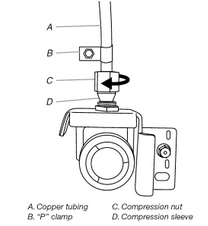
- Turn on water supply to refrigerator and check for leaks. Correct any leaks.
Style 2
- Unplug refrigerator or disconnect power.
- Remove and discard the short, black plastic part from the end of the water line inlet.
- Thread the nut onto the end of the tubing. Tighten the nut by hand. Then tighten it with a wrench two more turns. Do not overtighten.
NOTE: To avoid rattling, be sure the copper tubing does not touch the cabinet's side wall or other parts inside the cabinet.
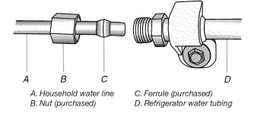
- Install the water supply tube clamp around the water supply line to reduce strain on the coupling.
- Turn shutoff valve ON.
- Check for leaks. Tighten any connections (including connections at the valve) or nuts that leak.
- On some models, the ice maker is equipped with a built-in water strainer. If your water conditions require a second water strainer, install it in the 1/4"(6.35 mm) water line at either tube connection. Obtain a water strainer from your appliance dealer.
Complete the Installation
- Plug into a grounded 3 prong outlet.
- Flush the water system. See "Water and Ice Dispensers."
- NOTE: Allow 24 hours to produce the first batch of ice. Discard the first three batches of ice produced. Allow 3 days to completely fill the ice storage bin.
Handle Installation and Removal
Parts Included: Door handles (2), Drawer handle(s) (1 or 2 depending on model), 1/8"hex key, spare setscrew(s)
NOTE: With the handles laying on a flat surface, the handles intended for the drawers are more curved. They will not mount flush against the doors.
Install Handles
NOTE: Handle mounting setscrews are preinstalled inside the handle.
- Remove the handles from the packaging inside the refrigerator, and place them on a soft surface.
- Open a refrigerator compartment door. On the closed door, place a handle onto the shoulder screws so that the setscrews are facing the adjacent door.

- Firmly push the handle toward the door until the handle base is flush against the door.
- While holding the handle, insert the short end of the hex key into the upper hole and slightly rotate the hex key until it is engaged in the setscrew.
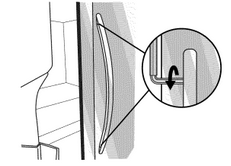
- Using a clockwise motion tighten the setscrew just until it begins to contact the shoulder screw. Do not fully tighten.
- Repeat steps 4 and 5 to fasten the lower setscrew.
- Once both setscrews have been partially tightened as instructed in the previous steps, fully tighten both setscrews.
IMPORTANT: When the screws feel tight, tighten them an additional quarter-turn. The handle is not properly installed without this extra tightening.
- Repeat steps 2 through 7 to install the other handle onto the adjacent refrigerator door.
- With the drawer(s) closed, place the handle onto the shoulder screws so that the setscrews are facing down toward the floor.
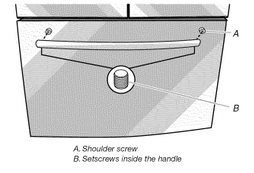
- Firmly push the handle toward the drawer until the handle base is flush against the drawer.
- Insert the short end of the hex key into the left-hand hole and slightly rotate the hex key until it is engaged in the setscrew.
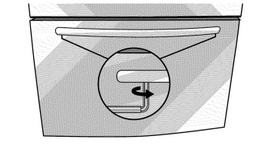
- Using a left to right motion tighten the setscrew a quarter-turn at a time just until it begins to contact the shoulder screw. Do not fully tighten.
- Repeat steps 11 and 12 to fasten the right-hand setscrew to the shoulder screw.
- Once both setscrews have been partially tightened as instructed in the previous steps, fully tighten both setscrews. IMPORTANT: When the screws feel tight, tighten them an additional quarter-turn. The handle is not properly installed without this extra tightening.
- For some models, repeat steps 9 through 14 to install a handle on the second drawer.
- Save the hex key and all instructions.
Remove the Handles
- While holding the handle, insert the short end of the hex key into a setscrew hole and slightly rotate the hex key until it is engaged in the setscrew.
- Using a right to left motion loosen the setscrew a quarter-turn at a time.
- Repeat steps 1 and 2 for the other setscrew. Slowly pull the handle away from the door or drawer.
- If necessary, use a Phillips screwdriver to remove the shoulder screws from the door.
Water Filtration $yste
Install the Water Filter
- Locate the accessory packet in the refrigerator and remove the water filter.
- Take the water filter out of its packaging and remove the cover from the O-rings. Be sure the O-rings are still in place after the cover is removed.
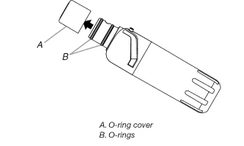
- The water filter compartment is located in the right-hand side of the refrigerator ceiling. Push up on the compartment door to release the catch, then lower the door.
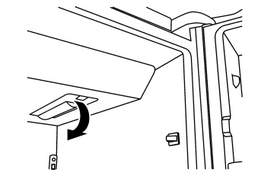
- Align the arrow on the water filter label with the cutout notch in the filter housing and insert the filter into the housing.
- Turn the filter clockwise 90 degrees (1/4turn), until it locks into the housing. NOTE: If the filter is not correctly locked into the housing, the water dispenser will not operate. Water will not flow from the dispenser.

- While the compartment door is still open, lift the filter up into the compartment. Then, close the filter compartment door completely.
- Flush the water system. See "Flushing the Water Filter" in the "Water and Ice Dispensers" section. IMPORTANT: If you do not flush the water system, you may experience dripping and/or decreased flow from the water dispenser.
The Water Filter Status Light
Press OPTIONS on the control panel to launch the Options menu. Press OPTIONS, under Filter Status, again to display the percentage of filter life remaining (from 100% to 0%). Press ICE MODE to return to the Normal screen.
The water filter status lights will help you know when to change your water filter.
- ORDER (yellow) - it is almost time to change the water filter. While you are dispensing water, "Order Filter" will blink seven times and sound an alert tone three times.
- REPLACE (red) - Replace the water filter. While you are dispensing water, "Replace Filter" will blink seven times and an alert tone will sound three times.
- RESET the water filter status tracking feature. After you replace the disposable water filter with a new filter, closing the filter compartment door will automatically reset the filter status tracking feature. See "Using the Controls."
NOTE: "Replace Filter" will remain illuminated if a filter is not installed or is installed incorrectly.
Replace the Water Filter
To purchase a replacement water filter, see "Accessories." Replace the disposable water filter when indicated on the water filter status display or at least every 6 months. If water flow to your dispenser or ice maker decreases noticeably, change the water filter sooner.
- Locate the water filter compartment in the right-hand side of the refrigerator ceiling. Push up to release and lower the compartment door.
- Turn the water filter counterclockwise (to the left), and pull it straight out of the compartment. NOTE: There may be some water in the filter. Some spilling may occur. Use a towel to wipe up any spills.
- Install the replacement water filter by following steps 2 through 7 in the "Install the Water Filter" section.
Install Air Filter (on some models)
An air filter is 15 times more powerful than baking soda at reducing common food odors inside the refrigerator.
On some models, your refrigerator's accessory packet includes an air filter, which must be installed prior to use.
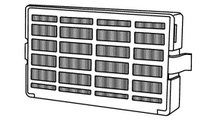
Installing the Air Filter
Install the air filter behind the vented door, located on the rear wall near the top of the refrigerator compartment.
- Remove the air filter from its packaging.
- Lift open the vented door.
- Snap the filter into place.
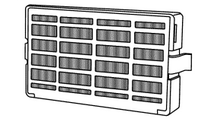
Installing the Filter Status Indicator
The filter comes with a status indicator, which should be activated and installed at the same time the air filter is installed.
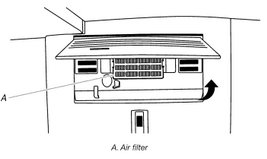
- Place the indicator face-down on a firm, flat surface.
- Apply pressure to the bubble on the back of the indicator until the bubble pops to activate the indicator.
- Lift open the vented air filter door. On some models, there are notches behind the door.
Replacing the Air Filter
The disposable air filter should be replaced every 6 months, when the status indicator has completely changed from white to red.
To order a replacement air filter, contact us. See "Accessories" in the User Guide, Use and Care Guide or User Instructions for information on ordering.
- Remove the used air filter by squeezing in on the side tabs.
- Remove the used status indicator.
- Install the new air filter and filter status indicator using the instructions in the previous sections.
Install Produce Preserver (on some models}
The produce preserver absorbs ethylene, to slow the ripening process of many produce items. As a result, certain produce items will stay fresh longer.
Ethylene production and sensitivity varies depending on the type of fruit or vegetable. To preserve freshness, it is best to separate produce with sensitivity to ethylene from fruits that produce moderate to high amounts of ethylene.
Installing the Produce Preserver
- Find the Produce Preserver housing inside the refrigerator.
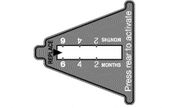
- Open the housing by pulling up and out on the back.
- Remove the Produce Preserver pouches from the packaging and place them into the housing. NOTE: For best performance, always use two pouches.
- Adhere the Produce Preserver housing to the back wall of the crisper drawer according to the instructions included in the package.
Installing the Status Indicator
The produce preserver comes with a status indicator, which should be activated and installed at the same time the pouches are installed.
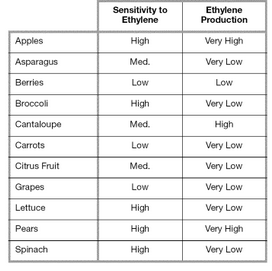
- Place the indicator face-down on a firm, flat surface.
- Apply pressure to the bubble on the back of the indicator until the bubble pops, to activate the indicator.
- Slide open the cap on the top of the produce preserver housing.
- Place the indicator in the top of the housing, facing outward.
- Slide the cap closed, and check that the indicator is visible through the rectangular hole in the cap.
NOTE: The cap will not easily close if the indicator's bubble has not been popped.
Using the Controls
Viewing and Adjusting Temperature Set Points
For your convenience, your refrigerator and freezer temperature controls are set to the recommended set points at the factory.
When you first install your refrigerator, make sure the temperature controls are still set to the recommended set points. The recommended set points are 37°F (3°C) for the refrigerator and 0°F (-18°C) for the freezer.
IMPORTANT:
- Wait 24 hours before you put food into the refrigerator. If you add food before the refrigerator has cooled completely, your food may spoil. NOTE: Adjusting the set points to a colder than recommended setting will not cool the compartments any faster.
- If the temperature is too warm or too cold in the refrigerator or freezer, first check the air vents to be sure they are not blocked before adjusting the controls.
- The recommended set points should be correct for normal household use. The controls are set correctly when milk or juice is as cold as you like and when ice cream is firm. NOTE: Areas such as a garage or porch, may experience hotter or colder temperatures and higher humidity than inside the home. You may need to adjust the temperature away from the recommended set points to accommodate for these conditions.
Adjust Temperature Set Points
Refrigerator set point range: 33°F to 45°F (0°C to 7°C).
Freezer set point range: -5°F to 5°F (-21°C to -15°C).
- Press and hold TEMPERATURE for 3 seconds to activate Temperature mode.
- When Temperature mode is activated, press TEMPERATURE to select the Refrigerator zone. The display will show the temperature set point of the selected compartment, as shown.
- Press LOCK, under plus, to raise the set point, or press OPTIONS, under minus, to lower the set point.
- When you have finished adjusting the refrigerator set point, press TEMPERATURE to change the display to show the freezer set point. When the zone has been changed, "FREEZER" appears on the display screen.
Additional Features
Sabbath Mode
Sabbath Mode is designed for those whose religious observances require turning off the lights and dispensers.
In Sabbath Mode, the temperature set points remain unchanged, but the interior and dispenser lights turn off, all sounds and alarms, and the dispenser paddles are disabled.
- To turn on Sabbath Mode, press and hold LIGHT and OPTIONS at the same time for 3 seconds. When the feature turns on, "Sabbath Mode" will appear on the dispenser display.
- To turn off Sabbath Mode, press and hold LIGHT and OPTIONS, at the same time, for 3 seconds. The screen will display the settings as they were before Sabbath Mode was turned on. However, the Max Cool and Max Ice features, will remain off until they are selected again.
NOTES:
- Turning "Cooling Off" will cancel Sabbath Mode
- If a power outage occurs while in Sabbath Mode, Power Outage will not be indicated on the display no matter how long the power was out.
Vacation Mode
In Vacation Mode, the freezer will defrost less often to conserve energy.
- To turn on Vacation Mode, press and hold TEMPERATURE and OPTIONS at the same time for 3 seconds. When the feature turns on, "VAC" will appear on the dispenser display.
- To turn off Vacation Mode, press and hold TEMPERATURE and OPTIONS at the same time, again, for 3 seconds. The screen will display the settings as they were before Vacation Mode was turned on.
NOTES:
- During the first hour after Vacation Mode is turned on, opening and closing the refrigerator door will not affect the setting. After 1 hour has passed, opening and closing the refrigerator door will turn off Vacation Mode.
- While in Vacation Mode, if Max Ice, Max Cool or Sabbath Mode is turned on, it will cancel Vacation Mode.
Water and Ice Dispensers
Flush the Water System
Air in the water dispensing system can cause the water dispenser to drip. After connecting the refrigerator to a water source or replacing the water filter, flush the water system.
Flushing the water dispensing system, forces air from the water line and filter and prepares the water filter for use. Additional flushing may be required in some households.
NOTE: As air is cleared from the system, water may spurt out of the dispenser.
- Using a sturdy container, depress and hold the water dispenser paddle for 5 seconds.
- Release the dispenser paddle for 5 seconds. Repeat steps 1 and 2 until water begins to flow.
- Once water begins to flow, continue depressing and releasing the dispenser pad (5 seconds on, 5 seconds off) until a total of 3 gal. (12 L) has been dispensed.
To Clean the Ice Dispenser Chute
Humidity causes ice to naturally clump together. Ice particles can build up until the ice dispenser chute becomes blocked.
If ice is not dispensed regularly, it may be necessary to empty the ice storage bin and clean the ice delivery chute, the ice storage bin and the area beneath the storage bin every 2 weeks.
- If necessary, remove the ice clogging the storage bin and delivery chute, using a plastic utensil.
- Clean the ice delivery chute and the bottom of the ice storage bin using a warm, damp cloth and dry thoroughly.
Ice Maker and Ice Storage Bin ( on some models)
IMPORTANT: To avoid low ice production and poor quality ice, flush the water system before turning on the ice maker. See "Water Dispenser."
- Allow 24 hours to produce the first batch of ice. Discard the first three batches of ice produced. Allow 2 to 3 days for the storage bin to fill completely following installation.
- The quality of your ice will be only as good as the quality of the water supplied to your ice maker. Avoid connecting the ice maker to a softened water supply. Water softener chemicals (such as salt) can damage parts of the ice maker and lead to poor quality ice. If a softened water supply cannot be avoided, make sure the water softener is operating properly and is well maintained.
- If the ice in the storage bin clumps together, break up ice using a plastic utensil and discard. Do not use anything sharp to break up the ice. This can cause damage to the ice bin and the dispenser mechanism.
- Do not store anything in the ice storage bin.
Ice Production Rate
- The ice maker should produce approximately 3 Ibs (1.4 kg) of ice per day under normal operation.
- To increase ice production, select the increased ice production feature from the Options menu on the control panel. See "Using the Control(s)."
Crisper and Crisper Cover
The humidity level in the crisper drawers is automatically regulated, so there is no humidity control.
To remove and replace a crisper drawer:
- Remove the drawer by pulling it open halfway. Then, lift up on the drawer to remove it completely. NOTE: If you unintentionally pull open the drawer to the drawer stop, it will lock in place and you will not be able to lift the drawer up and out.
- Replace a drawer by placing it on the slide rails and pushing it back into position past the drawer stop.
To remove the crisper(s) cover:
- Remove crisper(s).
- Holding the glass insert firmly with one hand, press up in center of glass insert until it rises above the plastic frame. Gently slide the glass insert forward to remove.
- Lift the cover frame up and remove it.
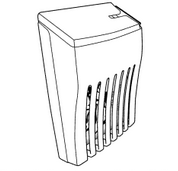
To replace crisper(s) cover:
- Fit back of cover frame into supports on side walls of the refrigerator and lower the front of the cover frame into place.
- Slide rear of glass insert into cover frame and lower front into place.
Cleaning
Interior Cleaning
- Unplug refrigerator or disconnect power.
- Hand wash, rinse, and dry removable parts and interior surfaces thoroughly. Use a clean sponge or soft cloth and a mild detergent in warm water.
- NOTE: Do not use abrasive or harsh cleaners such as window sprays, scouring cleansers, flammable fluids, cleaning waxes, concentrated detergents, bleaches or cleansers containing petroleum products on plastic parts, interior and door liners or gaskets.
- Plug in refrigerator or reconnect power.
Condenser Cleaning
There is no need for routine condenser cleaning in normal home operating environments. If the environment is particularly greasy or dusty, or there is significant pet traffic in the home, the condenser should be cleaned every 2 to 3 months to ensure maximum efficiency.
If you need to clean the condenser:
- Unplug refrigerator or disconnect power.
- Remove the base grille.
- Use a vacuum cleaner with a soft brush to clean the grille, the open areas behind the grille and the front surface area of the condenser.
- Replace the base grille when finished.
- Plug in refrigerator or reconnect power.
TROUBLESHOOTING
There is interior moisture buildup
NOTE: Some moisture buildup is normal
- The room is humid
A humid environment contributes to moisture buildup.
- The door(s) are opened often or not closed completely,
Allows humid air to enter the refrigerator. Minimize door openings and close doors completely.
- The door is blocked open
Move food packages away from door.
- A bin or shelf is in the way
Push bin or shelf back into the correct position.
- Storing liquid in open containers
This adds humidity to the refrigerator interior. Keep all containers tightly covered.
The ice maker is not producing ice or is not producing enough ice
- The refrigerator is not connected to a water supply or the water supply shutoff valve is not turned on.
Connect refrigerator to water supply and turn water shutoff valve fully open.
- There is a kink in the water source line.
A kink in the line can reduce water flow. Straighten the water source line.
- The ice maker is not turned on.
Make sure the ice maker is on. See "Ice Maker and Ice Storage Bin."
- The refrigerator has just been installed.
Wait 24 hours after ice maker installation for ice production to begin. Wait 3 days for full ice production.
- The refrigerator door is not closed completely.
Close the door firmly. If it does not close completely, see "The doors will not close completely."
Water from the dispenser is warm
- Water from the dispenser is chilled to 50°F (10°C).
This is normal.
- The refrigerator has just been installed.
Allow 24 hours after installation for the water supply to cool completely.
- A large amount of water was recently dispensed.
Allow 3 hours for the water supply to cool completely.
- Water has not been recently dispensed,
The first glass of water may not be cool. Discard the first glass of water dispensed.
- The refrigerator is not connected to a cold water pipe.
Make sure the refrigerator is connected to a cold water pipe. See "Water Supply Requirements."
The ice cubes are hollow or small
- The water shutoff valve is not fully open.
Turn the water shutoff valve fully open.
- A water filter is installed on the refrigerator,
Remove filter and operate ice maker. If ice quality improves, then the filter may be clogged or incorrectly installed. Replace filter or reinstall it correctly.
- A reverse osmosis water filtration system is connected to your cold water supply.
This can decrease water pressure. See "Water Supply Requirements."
- Questions remain regarding water pressure.
Call a licensed, qualified plumber.
See other models: KICU565WSS0 KWCU205HBT1 KDTE104ESS1 KFP720WH2 KDFE104DBL3
